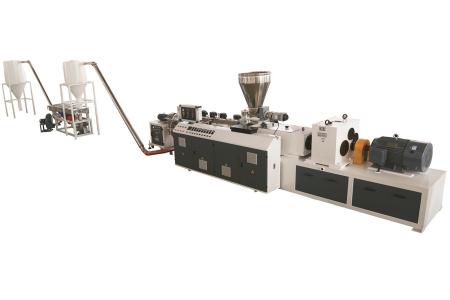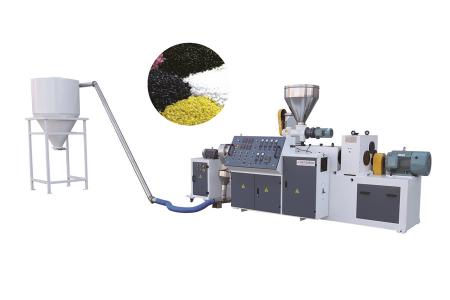Golden Far East Machinery Co.,Ltd.
Manufacturing Plastic Machinery Factory
PVC (Polyvinyl Chloride) pipes have become a staple in modern construction and infrastructure due to their versatility, durability, and cost-effectiveness. Whether in residential, commercial, or industrial settings, PVC pipes offer a reliable solution for a wide range of applications. This article delves into the various uses of PVC pipes and explores the different methods of connecting them to ensure optimal performance and longevity.
PVC pipesare made from a synthetic plastic polymer called polyvinyl chloride, which is known for its strong, lightweight, and flexible properties. These characteristics make PVC pipes suitable for a variety of applications, ranging from plumbing and irrigation to electrical conduit systems and industrial pipelines. Over the years, PVC pipes have gained popularity due to their resistance to corrosion, chemicals, and environmental stressors, making them a preferred choice for many industries.

PVC pipes are utilized in numerous sectors, each benefiting from the material's unique properties. Below are some of the most common applications:
1. Plumbing and Water Distribution Systems
PVC pipes are widely used in plumbing systems for both residential and commercial buildings. Their corrosion-resistant nature ensures that water remains uncontaminated, making them ideal for potable water distribution. PVC pipes are also easy to install and maintain, which contributes to their widespread use in water supply systems.
2. Sewage and Drainage Systems
The durability and chemical resistance of PVC pipes make them a popular choice for sewage and drainage systems. These pipes can handle the acidic and alkaline waste materials commonly found in sewage, ensuring a long service life with minimal maintenance. Additionally, PVC pipes' smooth interior surface reduces the risk of blockages and allows for efficient wastewater flow.
3. Irrigation Systems
In agriculture, PVC pipes are commonly used for irrigation due to their ability to withstand varying pressures and environmental conditions. Whether for small-scale garden irrigation or large agricultural fields, PVC pipes offer a reliable solution that is easy to install and modify as needed.
4. Electrical Conduits
PVC pipes serve as excellent electrical conduits, protecting wiring from moisture, chemicals, and physical damage. Their non-conductive nature makes them safe for use in both underground and above-ground electrical installations. Additionally, PVC conduits are fire-resistant, adding an extra layer of safety to electrical systems.
5. Industrial Applications
In industrial settings, PVC pipes are used for transporting chemicals, gases, and other fluids. Their resistance to corrosion and chemical degradation makes them suitable for harsh environments where other materials might fail. Industries such as chemical processing, manufacturing, and oil and gas frequently rely on PVC pipes for safe and efficient fluid transportation.
6. HVAC Systems
PVC pipes are also used in heating, ventilation, and air conditioning (HVAC) systems. They are often employed in ductwork and ventilation systems due to their ability to resist corrosion and handle varying temperatures. PVC pipes' lightweight nature makes them easy to install in complex HVAC systems, ensuring efficient airflow and temperature regulation.
7. Construction and Infrastructure Projects
PVC pipes are increasingly used in large-scale construction and infrastructure projects, such as roadways, bridges, and tunnels. Their durability and resistance to environmental stressors make them ideal for use in stormwater management, culverts, and other drainage applications.
The connection method used for PVC pipes is crucial for ensuring a leak-proof, secure, and long-lasting system. Several techniques can be employed, depending on the specific application and environmental conditions.
Solvent cementing is one of the most common methods for joining PVC pipes. This process involves applying a special solvent cement to the outside of the pipe and the inside of the fitting. The solvent temporarily softens the PVC material, allowing the pipe and fitting to fuse together as the solvent evaporates. The result is a strong, watertight connection that can withstand significant pressure.
Steps for Solvent Cementing:
Clean the pipe and fitting surfaces to remove any dirt, grease, or debris.
Apply the solvent cement evenly to both the pipe and fitting.
Quickly insert the pipe into the fitting, ensuring it is fully seated.
Hold the connection in place for a few seconds to allow the cement to set.
Advantages:
Provides a permanent, leak-proof seal.
Quick and easy to apply.
Suitable for high-pressure applications.
Disadvantages:
Requires careful handling of the solvent cement, as it can be harmful if inhaled or ingested.
The joint cannot be easily disassembled once the solvent has set.
Threaded connections are commonly used for smaller PVC pipes, especially in plumbing and irrigation systems. This method involves cutting external threads onto the pipe end and internal threads into the fitting. The two threaded components are then screwed together, often with the addition of thread sealant or Teflon tape to ensure a tight seal.
Steps for Threaded Connections:
Cut threads onto the pipe using a pipe threading tool.
Apply thread sealant or Teflon tape to the male threads.
Screw the pipe into the fitting, ensuring it is hand-tightened.
Use a wrench to tighten the connection slightly further, but avoid over-tightening.
Advantages:
Allows for easy disassembly and reassembly of the connection.
Suitable for low to moderate pressure systems.
Ideal for systems that may require future maintenance or modifications.
Disadvantages:
Not as strong or leak-proof as solvent cemented joints.
Requires careful alignment to avoid cross-threading.
Flanged connections are typically used in industrial applications where frequent disassembly of the pipeline is required. This method involves attaching flanges to the ends of the PVC pipes and bolting them together with a gasket in between to ensure a leak-proof seal.
Steps for Flanged Connections:
Attach the flanges to the pipe ends using solvent cement or a mechanical connection.
Place a gasket between the two flanges.
Align the flanges and insert the bolts through the bolt holes.
Tighten the bolts in a crisscross pattern to evenly distribute the pressure and create a secure seal.
Advantages:
Allows for easy disassembly and maintenance of the pipeline.
Provides a strong, leak-proof connection suitable for high-pressure applications.
Ideal for large-diameter pipes and industrial systems.
Disadvantages:
Requires precise alignment and tightening of bolts.
More time-consuming and labor-intensive compared to other methods.
Higher cost due to the additional components required.
Compression fittings are commonly used in plumbing and irrigation systems where a quick and reliable connection is needed without the use of solvents or adhesives. This method involves placing a compression ring and nut onto the pipe end, which is then compressed against a fitting to create a watertight seal.
Steps for Compression Fittings:
Slide the compression nut and ring onto the pipe.
Insert the pipe into the fitting.
Slide the compression ring up to the fitting and screw the compression nut onto the fitting.
Tighten the nut by hand, then use a wrench to secure the connection further.
Advantages:
Quick and easy to install.
Suitable for systems that require frequent disassembly and reassembly.
No need for solvents or adhesives.
Disadvantages:
Not suitable for high-pressure applications.
The seal may weaken over time, requiring periodic maintenance.
Heat fusion, also known as thermal welding, is a method used primarily for connecting large-diameter PVC pipes in industrial and municipal applications. This technique involves heating the pipe ends and fittings until they become soft and then pressing them together to form a solid, homogeneous joint.
Steps for Heat Fusion:
Heat the pipe ends and fitting surfaces using a specialized heating tool.
Once the surfaces are sufficiently heated, press the pipe and fitting together.
Hold the joint in place until it cools and solidifies.
Advantages:
Creates a strong, permanent joint that can withstand high pressures and environmental stresses.
Ideal for large-diameter pipes and critical systems.
Disadvantages:
Requires specialized equipment and trained personnel.
More time-consuming and expensive compared to other methods.
Once fused, the joint cannot be disassembled.

PVC pipes play a vital role in a wide range of applications, from residential plumbing to industrial pipelines. Understanding the various connection methods available is crucial for ensuring that PVC piping systems are secure, efficient, and long-lasting. Whether using solvent cementing for a watertight seal, flanged connections for industrial applications, or compression fittings for easy maintenance, each method offers unique advantages that cater to specific needs.
By selecting the appropriate connection method and adhering to proper installation techniques, PVC pipe systems can provide reliable service for years to come. As industries continue to seek durable, cost-effective, and environmentally friendly materials, PVC pipes will undoubtedly remain a cornerstone of modern infrastructure and development.